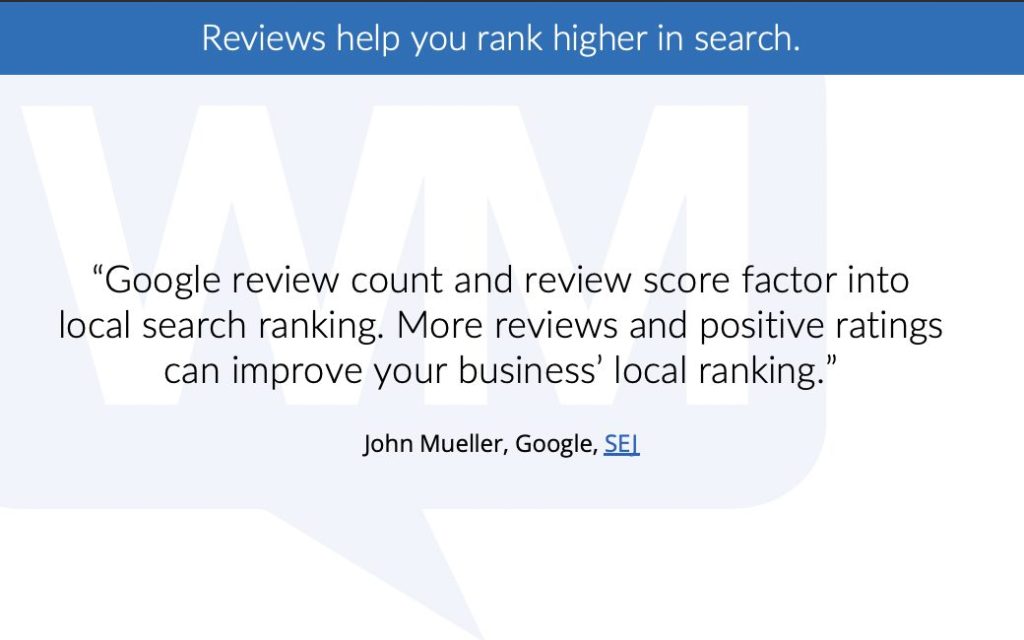In today’s digital world, online reviews and reputation management matter to your dental practice more than ever. Ninety-four percent of patients use online reviews to evaluate providers, and 72% look at reviews as their first step to finding a new provider or to confirm practice credentials. Positive reviews help patients gain trust and confidence to choose your practice.
Additionally, reviews serve as a key ranking factor for Google Search. This means they help you with search engine optimization (SEO), or showing up organically on Google search. Google views positive reviews as evidence of your business’s expertise, authority and trust (EAT), so having an extensive range of positive reviews helps you show up when a patient searches for a new dental practice.
Your Local SEO is also improved by online reviews. You’ll have a higher chance of showing up in the local pack results, which are the first three businesses that show up in a Google search query when a prospective patient searches “dentist near me” or for a dentist in their specific town:
Here, we take you through a prospective patient’s journey and the importance of reviews in this process — and the patient’s ultimate choice to convert.
A Prospective Patient’s Journey, Using Reviews
Say, for example, a mother is looking for an orthodontist because her daughter needs braces. Her general dentist may refer her to an orthodontist, or a close friend who also has a daughter with braces may provide a recommendation.
Reviews and Online Research
Before this mother calls the recommended orthodontist for her daughter, she’ll likely do some online research to find out more about the practice. If your practice has a well-optimized website and a strategic Google Ads plan in place, all kinds of excellent information — along with your five-star online reviews — should come up.
Your Website and Online Reviews
Now, say the mother does head over to your website to find out more about you. If you have a reviews page on your website where patients can view recent reviews from your current patients, this provides a centralized location where she can both learn about your practice and read all the wonderful things your current patients have to say.
Opportunities for Future Reviews from Prospective Patients
If this mother ultimately does decide to convert and has her daughter become a patient of your practice, this is a great opportunity to utilize her feedback as part of your reviews strategy.
If you have a patient reviews program in place for your practice, you can send the mother a review request following her daughter’s first appointment while the experience is still fresh in her mind. Her five-star review will add to your repertoire.
This requires that you have a solid patient review program in place for your practice. Additionally, you should always be prepared for negative feedback as well. Make sure you have a plan in place to turn negative reviews into positive opportunities for your practice.
Developing a Proactive Reviews Strategy
Say your practice wants to establish a solid review strategy to improve your EAT, acquire new patients and build your reputation among the community. It’s critical you develop a program that is both manageable and sustainable, and that can be quickly activated in the case of new patients — as seen above in our prospective patient journey-telling. Being proactive is the key here.
Think About Your Review Goals
How many reviews would you like to receive each month? Remember, this number must be feasible — set yourself up for success, rather than disappointment. The three priority sites for patient reviews are:
- Healthgrades
Identify How You Will Manage This Program
An important part of this conversation is considering which members of your team will primarily handle reviews for your practice. You’ll also want to consider how you’ll incentivize your team in gaining positive reviews.
List the Opportunities to Ask Patients for Reviews
Common opportunities to ask patients for reviews include:
- Review requests on reception screen slides
- Flyers at your check-in desk
- Staff buttons
- Emails with a “Review Us” call-to-action (CTA)
- Website review links from Reviews page
- In-office check-in tablet
- In-office review from cell phone
- Post-appointment review email
- Post-appointment review text
- Website reviews page
Outline Your Review Monitoring and Response Strategy
Review responses can make or break your review strategy. Having a solid program in place to gain reviews is one thing, but whether or not you take the time to respond to reviews and handle any negative reviews that may come in is a major factor in securing your online reputation.
Keep these three principles in mind when it comes to monitoring and responding to reviews:
- Monitor and respond to reviews from all review sites.
- Respond to every review, even star-only and negative reviews.
- Respond promptly and sincerely to all reviews.
Promoting Awareness of Your Reviews
Now that you have a solid review program in place, you must promote awareness of it to your patients. The most effective review promotion tactics we’ve seen include:
- Adding a Reviews page to your website
- Posting reviews on your Facebook page and Google My Business profile with a “thank you for your feedback” message
- Including a recent patient review in your patient emails
- Adding live reviews to your website
Need Help Developing a Strategic Reviews Plan?
At Whiteboard Marketing, reviews and reputation management is an integral part of our digital marketing services. If you have any questions regarding your practice reviews program, contact us or download our How to Build a Patient Review Program for Your Practice worksheet.












